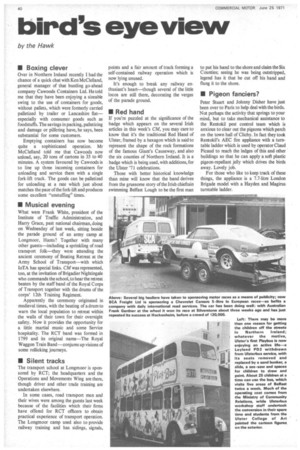birds eye view
Page 42

If you've noticed an error in this article please click here to report it so we can fix it.
by the Hawk • Boxing clever
Over in Northern Ireland recently I had the chance of a quick chat with Ken McClelland, general manager of that bustling go-ahead company Cawoods Containers Ltd. He told me that they have been enjoying a sizeable swing to the use of containers for goods, without pallets, which were formerly carried palletized by trailer or Lancashire flat— especially with consumer goods such as foodstuffs. The savings in packing, palletizing and damage or pilfering have, he says, been substantial for some customers.
Emptying containers has now become quite a sophisticated operation. Mr McClelland told me that Cawoods now unload, say, 20 tons of cartons in 35 to 40 minutes. A system favoured by Cawoods is to line up three incoming containers for unloading and service them with a single fork-lift truck. The goods can be palletized for unloading at a rate which just about matches the pace of the fork-lift and produces some excellent "unstuffing'; times.
• Musical evening What were Frank White, president of the Institute of Traffic Administration, and Harry Grace, past national chairman, doing on Wednesday of last week, sitting beside the parade ground of an army camp at Longmoor, Hants? Together with many other guests—including a sprinkling of road transport folk—they were attending the ancient ceremony of Beating Retreat at the Army School of Transport—with which IoTA has special links. CM was represented, too, at the invitation of Brigadier Nightingale who commands the school, to hear the retreat beaten by the staff band of the Royal Corps of Transport together with the drums of the corps' 12th Training Regiment.
Apparently the ceremony originated in medieval times, with the beating of a drum to warn the local population to retreat within the walls of their town for their overnight safety. Now it provides the opportunity for a little martial music and some Service hospitality. The RCT band was formed in 1799 and its original name—The Royal Waggon Train Band—conjures up visions of some rollicking journeys.
• Silent tracks
The transport school at Longmoor is sponsored by RCT; the headquarters and the Operations and Movements Wing are there, though driver and other trade training are undertaken elsewhere.
In some cases, road transport men and their wives were among the guests last week because of the facilities which their firms have offered for RCT officers to obtain practical experience of transport operation. The Longmoor camp used also to provide railway training and has sidings, signals, points and a fair amount of track forming a self-contained railway operation which is now lying unused.
It's enough to break any railway enthusiast's heart—though several of the little locos are still there, decorating the verges of the parade ground.
• Red hand If you're puzzled at the significance of the badge which appears on the several Irish articles in this week's CM, you may care to know that it's the traditional Red Hand of Ulster, framed by a hexagon which is said to represent the shape of the rock formations of the famous Giant's Causeway, and also the six counties of Northern Ireland. It is a badge which is being used, with additions, for the Ulster '71 celebrations.
Those with better historical knowledge than mine will know that the hand derives from the gruesome story of the Irish chieftain swimming Belfast Lough to be the first man to put his hand to the shore and claim the Six Counties; seeing he was being outstripped, legend has it that he cut off his hand and flung it to the shore.
• Pigeon fanciers?
Peter Stuart and Johnny Disher have just been over to Paris to help deal with the birds. Not perhaps the activity that springs to your mind, but to take mechanical assistance to the Rentokil pest control team which is anxious to clear out the pigeons which perch on the town hall of Clichy. In fact they took Rentokil's AEC fire appliance with a turntable ladder which is used by operator Claud Picaud to reach the ledges of this and other buildings so that he can apply a soft plastic pigeon-repellant jelly which drives the birds away. Lovely job.
For those who like to keep track of these things, the appliance is a 7.7-litre London Brigade model with a Hayden and Magirus turntable ladder.




































































































